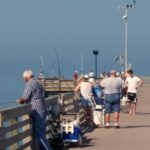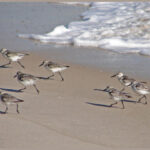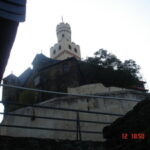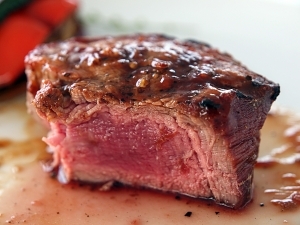Fall in Massachusetts and the Boston area is the time of year when even the most congested stretch of urban shoreline becomes prime fishing area, likewise Boston Harbor’s inner and outer islands: Spectacle, Long, Thompson, Green, Calf, Georges and the Brewsters. The harbor, both the inner and outer, and all of the islands’ shores, especially the low-tide shallows, will be filled herring, with striped bass and bluefish feeding aggressively during large-scale breaks off Carson Beach, City Point, the sugar bowl, within Pleasure Bay, off the McCorkle Pier at Castle Island and along the shores and seawall off UMass/Boston.
The big story, though, will be the keepers , 36″ and over, 25 lbs. and heavier, gliding over the low-water flats in the drain creek at Squaw Rock between Squantum and Thompson Island. This is three-feet deep water. Anglers won’t bother bringing bait from the local shop. Rather, they’ll stoop down, yank up a handful of mussels, crack them open, and use the innards as bait. Striped bass turn indiscriminate in their dining habits this time of year, and Squaw Rock anglers will fish from the area’s shoreline or with bait that ranges from mussels to herring to mackerel to live eels. When the tide is down, some will walk the gravel bar towards Thompson Island, fishing the bar and flats on either, using if not bait then long-range casing lures like Whistlers, bucktail jigs, Kastmasters and Rangers.
Meanwhile, over in Quincy, smelt will become active off the Marina Bay docks and water park, the bait live grass shrimp.
The fall run on the north shore will extend from Boston north, towards Marblehead – not only in Marblehead harbor (schoolies, mostly, except during the night and pre-dawn hours), but also Peaches Point at the mouth of the harbor and in the waters and along the shoreline extending east towards Childrens Island and west towards Tinkers Island along Marblehead Neck’s shores.
Marblehead’s secret is that The Neck, exclusive yacht-club atmosphere to the contrary, holds four public shore access points on its eastern shores where the yacht clubs aren’t. Peaches Point Light is the most obvious; the other three lie tucked between hedges and homes along the Neck’s eastern shore. Look for discrete parking signs on the right Ocean Street. Flounder, meanwhile, will hold steadier in nearby Salem Sound and its harbors: Beverly’s, Salem’s, Magnolia’s, Manchester’s.
The South Shore, from Quincy to Plymouth, will present the same story and more: fluke off Marshfield and in the Duxbury Bay channels, with the occasional school of football bluefin tuna ranging in as close to shore as High Pines Ledge and the Gurnet. Anglers who eschew pelagics in favor of larger groundfish will make the trip by themselves or party boat to Caches Ledge, where they’ll jig deep for cod, pollock, haddock. Many will use for deep jigging non-stretch line like Berkley Whiplash, which gives 65 lb. of strength on the diameter of 14 lb. monofilament.
Still other anglers will focus exclusively on Stellwaggen Bank, in search of larger bluefin feeding on sand eels. During a recent fall bluefin run one of my schoolboy chums, Vince Lambert, had the misfortune of coming across a breaking school of bluefin on Stellwaggen on a day when he had the wrong bait but the right gear (stout rods and huge Penn reels). No bait in the boat other than rotten herring. As he pulled in dogfish after dogfish in an effort to find bait more appropriate (whiting or bluefish), tuna were exploding out of the water. The same month, nearly a half-dozen small boats were flipped or swamped off Chatham by bluefin they landed.
(An Anecdote): Just a short while ago I was grinding along Misery Island off Manchester, Ma., on the North Shore, looking for a place. My fellow kayaking buddies were busily disappearing below the crests of the large swell, and rain was starting to fall. It was a pretty miserable day, raw and cold. All I wanted to do was land, eat my lunch and head home. When I turned into Great Misery Island Cove I saw the tell-tale signs which so often hold the clues to a long and happy tale. Two fellows were huddled over in the cockpit of a battered open powerboat, their arms pumping back in forth in unmistakable filleting motions.
They had fish in that boat.
I paddled over. Sure enough, arranged on the seat between them lay a whetstone, an old Dunkin Donuts bucket, and a mound of flounder fillets high as folded clothing.
“Nice-looking-catch, “I said. “What-were-you-using?”
Then:
“Where’d you get them?”
Nodding shoreward, filleting still, one answered,
“Over there,” and kept working.
Over there encompassed a section of coastline five miles long, a magnitude of over there-ness whose vagueness didn’t surprise me: few anglers are willing to divulge the location of a hotspot to someone they don’t know.
I checked my chart back home. Sure enough, there’s sand lies off Manchester’, miles of it. And as most anglers know, flounder tend for sand as like horses head to open fields.
The time to go to Manchester for flounder is fall, when stripers are heading back home and bluefin are holding offshore. Flounder hover in close along the shoreline in tight schools, plentiful and dependable. With everyone else focused on bass during the fall, you’ll have the place – and the fish – to yourself.






